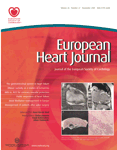-
PDF
- Split View
-
Views
-
Cite
Cite
Sigmund Silber, on behalf of the ESC-PCI Guidelines Task Force , ESC guidelines for percutaneous coronary interventions: reply, European Heart Journal, Volume 26, Issue 22, November 2005, Pages 2476–2477, https://doi.org/10.1093/eurheartj/ehi564
Close - Share Icon Share
The members of the ESC-PCI Guidelines Task Force1 greatly appreciate the thoughtful comments by Dr Dieker et al. and Dr Kholeif.
We are pleased that Dr Dieker agrees with us regarding the comparison between primary PCI and thrombolysis. We also agree that we have to wait for ASSENT-IV, OAT, and APRICOT-3 for further insights into the changing field of optimal STEMI treatment. However, regarding a ‘selective’ invasive strategy, i.e. in the case of recurrent ischaemia and/or haemodynamic instability, we do not think we differ with the last year's AHA/ACC STEMI guidelines2 because we still recommend this strategy at evidence level IB (Table 7, p. 8171). Our alternative recommendation of a routine coronary angiography after thrombolysis and PCI, if applicable, is not primarily based on ‘observational data from registries and subgroup analyses’ but rather on four randomized trials (Table 6, p. 8171). At this point, it is important to emphasize that we followed a general consensus demanding randomized trials with a primary clinical endpoint, adequately powered and reaching its primary endpoint to obtain levels of evidence A or B. As there are two randomized trials (SIAM-III and GRACIA-1) with a primary clinical endpoint adequately powered and with positive results comparing the benefit of early post-thrombolysis PCI vs. a conservative strategy, the level of evidence resulted in an ‘A’. For the ‘elective’ strategy of pre-discharge inducible ischaemia in patients with STEMI after thrombolysis, there is only a single randomized study (DANAMI-1), thus resulting in a level B. The critique of ‘clustering’ the four studies in Table 6 with a total of 1031 patients is well taken. However, Dr Dieker might consider that DANAMI-1 randomized 1008 patients, a number similar to the one he criticized. Predominantly, on the basis of GRACIA-1, we strongly believe that a routine invasive strategy after thrombolysis implementation in daily clinical practice comes at an adequate point in time and not too early as Dr Dieker suggests.
The other question raised by Dr Dieker requires more clarification. A routine invasive strategy after thrombolysis strategy consists in the use of a routine coronary angiography the next day (within 24 h) with elective (not primary) PCI, even in asymptomatic patients without demonstrable ischaemia, who received thrombolysis <12 h of STEMI. Therefore, the strategy we recommended differs from the concept of facilitated angioplasty. Facilitated angioplasty is defined as a planned intervention within 12 h after the onset of symptoms, soon after clot dissolving medication to bridge the delay between first medical contact and primary PCI. Our guidelines are indeed the first ones to make the point that thrombolysis is not the final treatment.
Dr Kholeif raises the important question of pre-hospital thrombolysis. The primary task of guidelines is to analyse the existing data, to draw practically oriented conclusions from these trials. Regarding the pre-hospital thrombolysis vs. primary PCI, however, there is only one single randomized trial with a primary clinical endpoint (CAPTIM), with no significant difference between both strategies. Therefore, on the basis of evidence, we could not recommend pre-hospital thrombolysis when primary PCI is available.
We agree that the interpretation of the registries presents a problem. Of course, registries reflect the ‘real world’ with a large number of patients. However, patients in registries are not randomized and the reported results may reflect the substantial bias of physicians. For example, if the sicker patients were referred for primary PCI and the more stable patients underwent thrombolysis, then the results would be as indicated. Regarding our assertion ‘In patients with STEMI, primary PCI should be the treatment of choice in patients presenting in a hospital with PCI facility and an experienced team’ there is a misunderstanding; we did not mean to recommend the presence of an on-site surgery.
Finally, Dr Kholeif raised the old but still important question whether guidelines should fit the available health care system or should the health care system follow the evidence. We are strong advocates of the latter option. For example, we all know the benefit of treatment with beta-blockers in patients with heart failure. However, in clinical practice, beta-blockers are given to only 58% of the patients.3 Does this mean we have to look for another alternative treatment for patients not receiving beta-blockers or is it better to enforce the implementation of guidelines in clinical practice? We assume that primary PCI is not available for all patients in all countries, and we do not doubt that the reperfusion strategy in a patient with non-PCI facilities should be fibrinolysis. However, we must remember that these guidelines are PCI guidelines, and we should insist that nowadays primary PCI is the gold standard of reperfusion in patients with STEMI. So, although we are aware that implementing a strategy of early PCI will carry enormous costs, the consequences of this approach will save lives worldwide. Practical recommendations of how to implement modern STEMI guidelines will be given soon.4
References
Silber S, Albertsson P, Aviles FF, Camici PG, Colombo A, Hamm C, Jorgensen E, Marco J, Nordrehaug JE, Ruzyllo W, Urban P, Stone GW, Wijns W. Guidelines for percutaneous coronary interventions: the task force for percutaneous coronary interventions of the European Society of Cardiology.
Antman EM, Anbe DT, Armstrong PW, Bates ER, Green LA, Hand M, Hochman JS, Krumholz HM, Kushner FG, Lamas GA, Mullany CJ, Ornato JP, Pearle DL, Sloan MA, Smith SC Jr. ACC/AHA guidelines for the management of patients with ST-elevation myocardial infarction.
Komajda M, Lapuerta P, Hermans N, Gonzalez-Juanatey JR, van Veldhuisen DJ, Erdmann E, Tavazzi L, Poole-Wilson P, Le Pen C. Adherence to guidelines is a predictor of outcome in chronic heart failure: the MAHLER survey.



